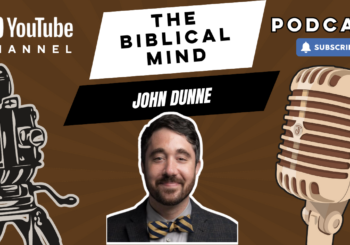Learning Empathy through Exile
Editor’s note: This year, the Jewish festival of Sukkot runs October 9–16. This article explores the significance of this holiday in the Bible and for today.
It wasn’t a simple matter for Tevye to remove his head covering, the Jewish kippah, in the 2015 revival of Fiddler on the Roof.
For months, Bartlett Sher, the Tony-winning director, debated 91-year-old Sheldon Harnick, the show’s Tony-winning lyricist and the last surviving member of the show’s original creative team, over how the classic production’s latest iteration should end. It would not be in the traditional manner. Eventually Harnick conceded; a striking change was made to the ending (and framing device) of one of America’s most beloved, most staged plays.
Enjoying this article? Read more from The Biblical Mind.
As Sher explained to the New York Times, the decision for Tevye to be bare-headed, wearing a red parka in a line of somber exiles marching slowly offstage, was an overtly political one. “You see him enter the line of refugees, making sure we place ourselves in the line of refugees, as it reflects our past and affects our present,” Mr. Sher said.
Amid constant debates over immigration and border policies, Sher wanted Anatevka’s most famous Jew to embody empathy for the Other, independent of religious or cultural affiliation.
The Hebrew Bible teaches, no fewer than 36 times, that we are to love the stranger, because the Israelites too were strangers in a strange land.
It also commands the Israelites, multiple times, to observe the festival of Sukkot (plural of “sukkah,” a temporary dwelling resembling a hut). In Exodus 23:16 the holiday is first mentioned as the “Festival of Ingathering,” in which the year’s agricultural production culminates. In Leviticus 23, more specifics are added, including that the Israelites are to go outside and dwell in temporary structures for seven days, “so that,” as God instructs, “generations will know that I housed the Children of Israel in sukkot when I took them out of Egypt.” Also mentioned are what are often referred to as the Four Species, traditionally believed to be the date palm, myrtle, willow, and etrog.
In Deuteronomy, the holiday is mentioned again, as a community-wide cause for joy (“you and your sons and daughters, your servants and maidservants, the Levite, stranger, orphan and widow in your gates”) meant to be celebrated in God’s chosen place. Once the Temple in Jerusalem was built, that location became the pilgrimage site for this national commemoration.
A few days before Sukkot begins, contemporary Jews observe the holiday by building a sukkah (usually with tarp walls, a metal or plastic frame, and a bamboo roof) in their yards or apartment complexes.
Millenia ago, the ancient rabbis wisely connected this holiday’s emphasis on desert wanderings with the acknowledgement of social and economic disparities.
Sitting in our temporary sukkah just a few feet from our actual permanent homes, in our driveway or in the local synagogue’s communal sukkah for those who don’t have room or the means for their own, we are meant to cultivate empathy for the exiled. We are to recall that we ourselves are, always, on some level, living a wandering existence.
In a profoundly preemptive interpretation, the Jewish sages of old envisioned Sukkot, a holiday which we are commanded elsewhere in the Bible to celebrate with joy, as voluntary exile. As a midrash recounts,
Rabbi Eliezer son of Marus taught: Why do we make a Sukkah after Yom Kippur? Since we find that on Rosh Hashana the Lord sat and judged humanity, and on Yom Kippur He sealed their judgement, maybe Israel was decreed to go into exile. Therefore, they make a sukkah and are exiled from their homes to the sukkah, and God counts it as if they have been exiled.1See Yalkut Shimoni Emor Remez 247.
Whether or not we are refugees, during Sukkot we are asked to feel the pain of those who are.
The Jewish story, as the historian Heinrich Graetz emphasized, has often been a lachrymose one. Suffering has been followed by dispersion, destruction followed by disaster, persecution followed by hate. The exile to Egypt became the Babylonian destruction of the first Temple in Jerusalem, which became the second being set aflame by the Romans, which became a 2,000-year exile rife with displacements, wanderings, massacres, blood libels, the Holocaust, and antisemitism across the globe. To be sure, the relative stability of recent decades in the United States, and the development and strengthening of the modern State of Israel have given Jews a level of security that would bewilder previous generations. But the Jew’s ability to relate to the refugee remains both an essential element of the Jewish consciousness and a core element of prayer, ritual, and even festivals.
As Sigrid MacRae has written, “The notion of home is a perpetual prickle that plagues all refugees and exiles.” Fashioned to commemorate the desert wanderings of our ancestors generations ago, the sukkah is a yearly reminder that whatever our own level of stability, our hearts and actions are with the stranger still wandering.
Unlike Broadway’s rendering, however, Sukkot’s lesson in empathy for the exiled comes not despite particularity but because of it. The sukkah does not ask us to relinquish what role we inhabit or remove what uniqueness we bear. It calls upon us to draw from the rawness and the resoluteness our people have felt as refugees throughout history in attuning us to those in need of restoration, comfort, and shelter today.
In another teaching, the Rabbis suggest that even the Four Species, held and ritually waved during prayers in synagogue, symbolize connectivity across societal divides.2Leviticus Rabbah 30:12. By binding together different species—representing different groups of Jews—all are elevated through the best of the bunch. The Rabbis, with this teaching, were modeling a conception of a polity that seeks to bind through bridge-building:
“The fruit of a beautiful tree”—these are [referring to] Israel. Just like this citron (etrog), which has taste and has smell, so too Israel has among them people that have Torah and have good deeds.
“The branches of a date palm”—these are [referring to] Israel. Just like this date, which has taste and has no smell, so too Israel has among them those that have Torah but do not have good deeds.
“And a branch of a braided tree (a myrtle)”—these are [referring to] Israel. Just like this myrtle, which has smell and has no taste, so too Israel has among them those that have good deeds but do not have Torah.
“And brook willows”—these are [referring to] Israel. Just like this willow, which has no smell and has no taste, so too Israel has among them people that have no Torah and have no good deeds.
And what does the Holy One, blessed be He, do to them? To destroy them is impossible, but rather the Holy One, blessed be He, said “bind them all together [into] one grouping and these will atone for those.” And if you will have done that, I will be elevated at that time.
This teaching reflects a belief that those most deeply committed spiritually have the opportunity to elevate all of society, in this world, let alone the next, through their efforts.
As the contemporary ethicist and theologian Leon Kass has noted,
People who have suffered estrangement and deprivation are more likely to feel sympathy for strangers and compassion for the needy than are those who have known only prosperity. . . . People nourished collectively in the wilderness are more likely to be grateful for the blessings of existence than are those who regard human life as a zero-sum game and grasp all they can for themselves.3Reading Exodus, 602.
The very structure of the sukkah, then, can help strengthen our empathy for those in need. Sukkot is an invitation to extend whatever measure of shelter we can build to include the stranger, whether helping those displaced by Hurricane Ian or welcoming an unfamiliar face to a warm holiday meal. It’s a reminder that empathy modeled after God’s protective clouds can be manifested with our own two hands, starting in our own backyard.
End Notes
1. See Yalkut Shimoni Emor Remez 247.
2. Leviticus Rabbah 30:12.
3. Reading Exodus, 602.
Image created by Rubner Durais
Subscribe now to receive periodic updates from the CHT.





